MBA402 - Risk Assessment: Trading.com Analysis on Governance & Ethics
VerifiedAdded on 2022/11/14
|14
|3208
|446
Report
AI Summary
This report provides a comprehensive risk assessment of Trading.com, a company offering share investment courses and consultation. Using the Risk Exposure Calculator, the analysis focuses on pressure points related to growth, culture, and information management. The assessment identifies growth as a high-risk factor due to aggressive performance targets and rapid expansion, leading to inexperienced employees and compromised service quality. Cultural risks stem from rewarding entrepreneurial risk-taking, resistance to negative feedback, and intense internal competition, fostering unethical practices. Information management faces challenges in transactional complexity, diagnostic performance gaps, and decentralized decision-making. The overall risk profile positions Trading.com in the medium-risk category, necessitating the implementation of effective strategies to mitigate these identified risks and ensure sustainable organizational growth. The report suggests that Trading.com needs to address these issues to improve its risk profile and ensure long-term success.
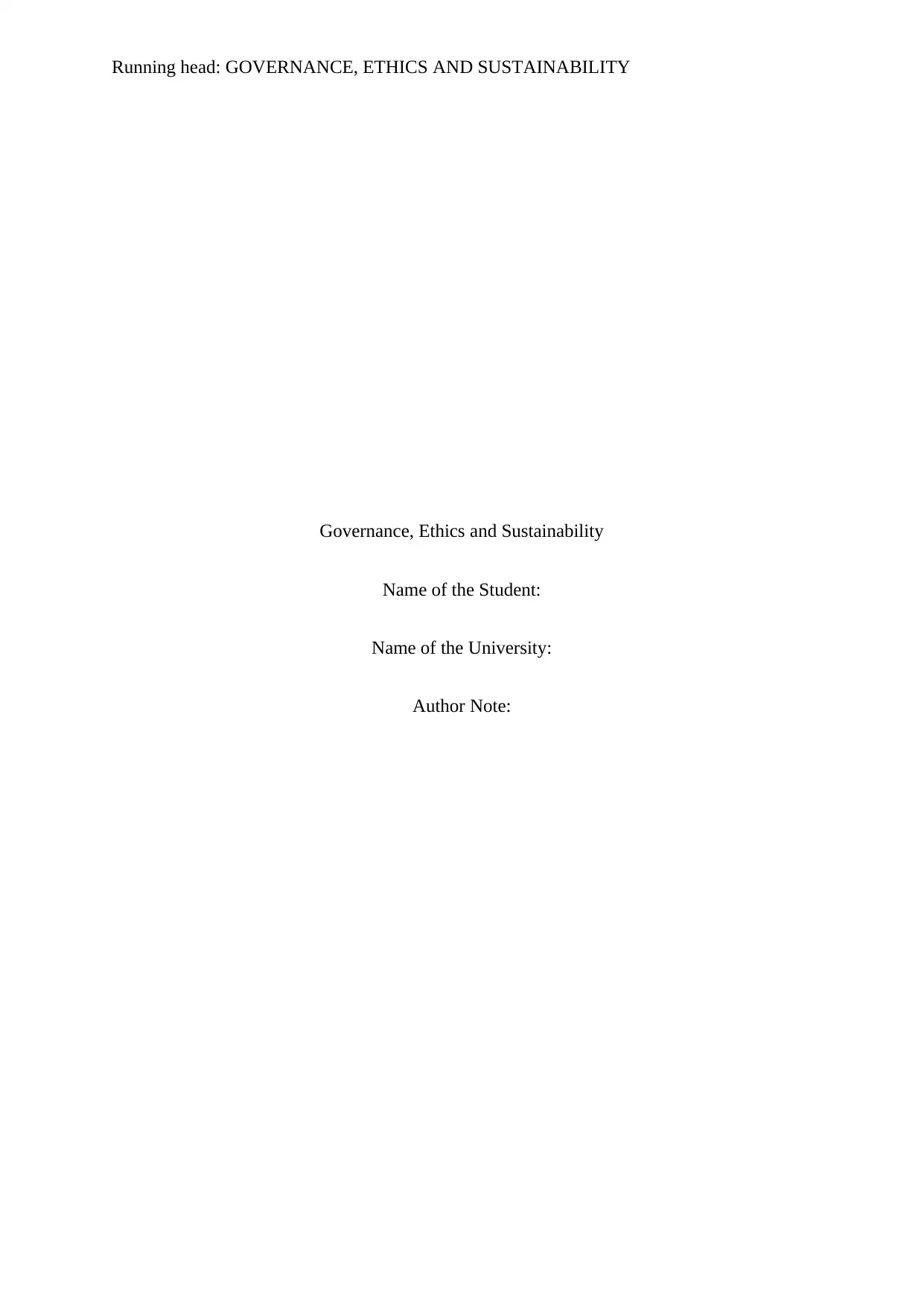
Running head: GOVERNANCE, ETHICS AND SUSTAINABILITY
Governance, Ethics and Sustainability
Name of the Student:
Name of the University:
Author Note:
Governance, Ethics and Sustainability
Name of the Student:
Name of the University:
Author Note:
Paraphrase This Document
Need a fresh take? Get an instant paraphrase of this document with our AI Paraphraser
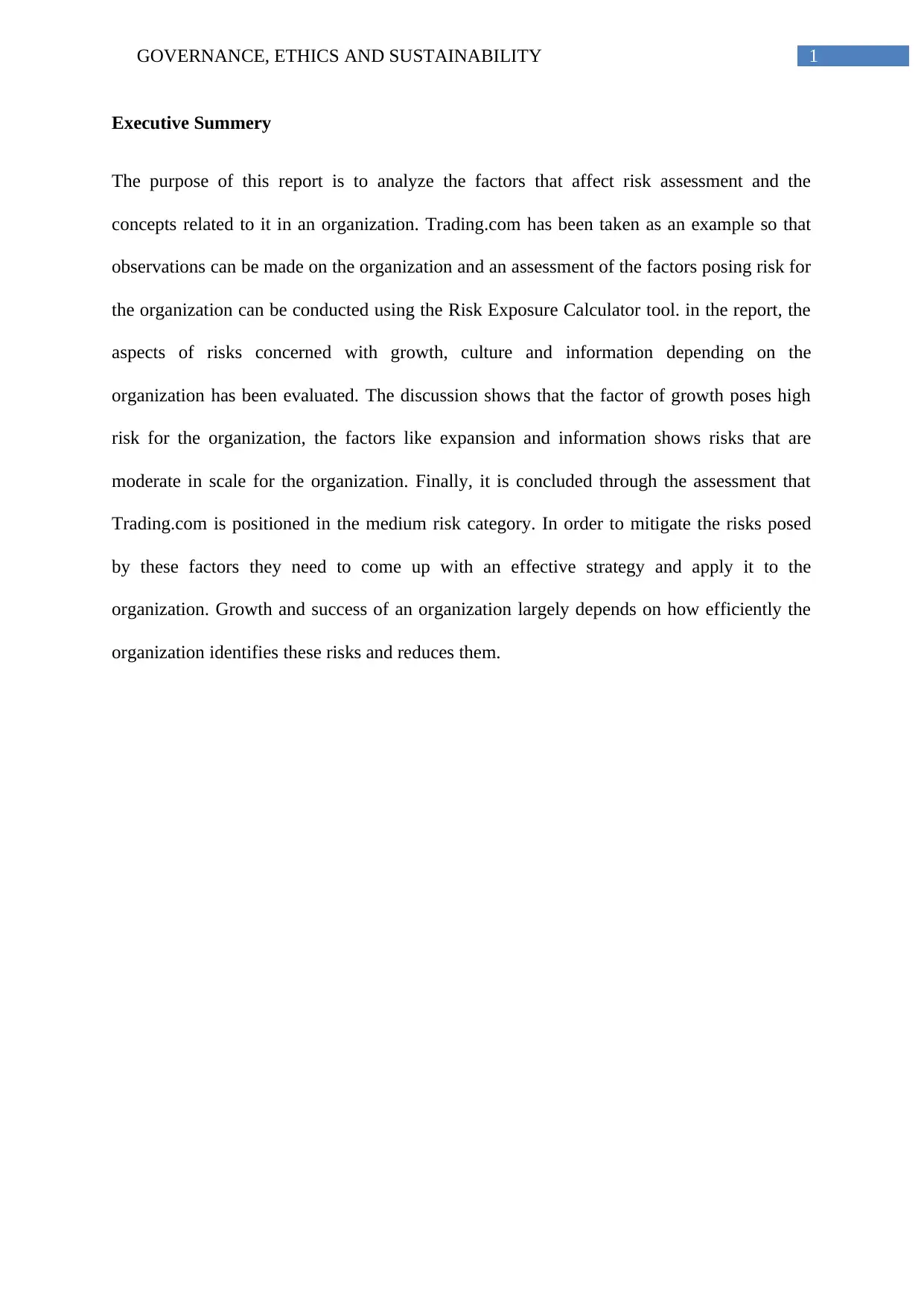
1GOVERNANCE, ETHICS AND SUSTAINABILITY
Executive Summery
The purpose of this report is to analyze the factors that affect risk assessment and the
concepts related to it in an organization. Trading.com has been taken as an example so that
observations can be made on the organization and an assessment of the factors posing risk for
the organization can be conducted using the Risk Exposure Calculator tool. in the report, the
aspects of risks concerned with growth, culture and information depending on the
organization has been evaluated. The discussion shows that the factor of growth poses high
risk for the organization, the factors like expansion and information shows risks that are
moderate in scale for the organization. Finally, it is concluded through the assessment that
Trading.com is positioned in the medium risk category. In order to mitigate the risks posed
by these factors they need to come up with an effective strategy and apply it to the
organization. Growth and success of an organization largely depends on how efficiently the
organization identifies these risks and reduces them.
Executive Summery
The purpose of this report is to analyze the factors that affect risk assessment and the
concepts related to it in an organization. Trading.com has been taken as an example so that
observations can be made on the organization and an assessment of the factors posing risk for
the organization can be conducted using the Risk Exposure Calculator tool. in the report, the
aspects of risks concerned with growth, culture and information depending on the
organization has been evaluated. The discussion shows that the factor of growth poses high
risk for the organization, the factors like expansion and information shows risks that are
moderate in scale for the organization. Finally, it is concluded through the assessment that
Trading.com is positioned in the medium risk category. In order to mitigate the risks posed
by these factors they need to come up with an effective strategy and apply it to the
organization. Growth and success of an organization largely depends on how efficiently the
organization identifies these risks and reduces them.
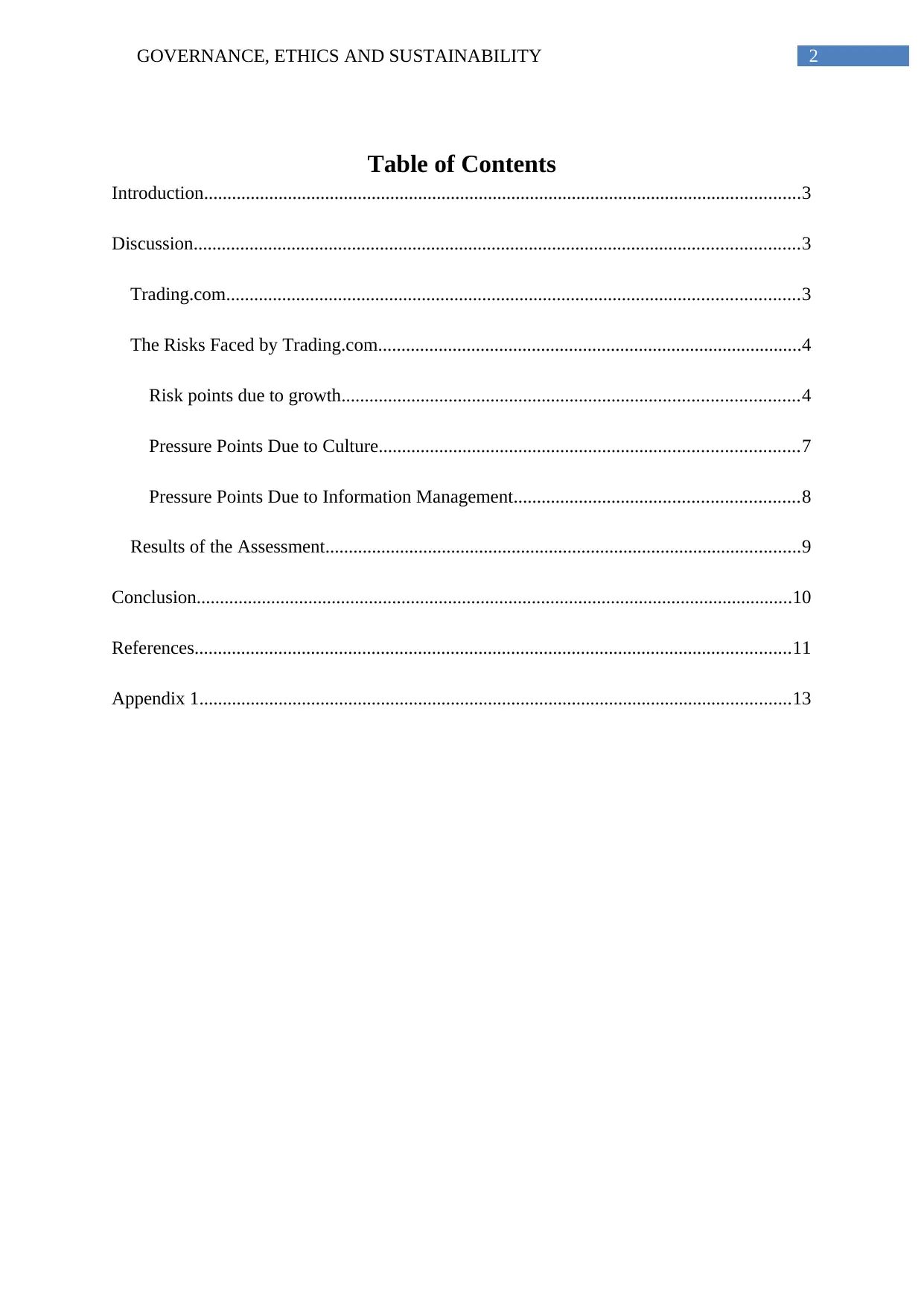
2GOVERNANCE, ETHICS AND SUSTAINABILITY
Table of Contents
Introduction................................................................................................................................3
Discussion..................................................................................................................................3
Trading.com...........................................................................................................................3
The Risks Faced by Trading.com...........................................................................................4
Risk points due to growth..................................................................................................4
Pressure Points Due to Culture..........................................................................................7
Pressure Points Due to Information Management.............................................................8
Results of the Assessment......................................................................................................9
Conclusion................................................................................................................................10
References................................................................................................................................11
Appendix 1...............................................................................................................................13
Table of Contents
Introduction................................................................................................................................3
Discussion..................................................................................................................................3
Trading.com...........................................................................................................................3
The Risks Faced by Trading.com...........................................................................................4
Risk points due to growth..................................................................................................4
Pressure Points Due to Culture..........................................................................................7
Pressure Points Due to Information Management.............................................................8
Results of the Assessment......................................................................................................9
Conclusion................................................................................................................................10
References................................................................................................................................11
Appendix 1...............................................................................................................................13
⊘ This is a preview!⊘
Do you want full access?
Subscribe today to unlock all pages.

Trusted by 1+ million students worldwide
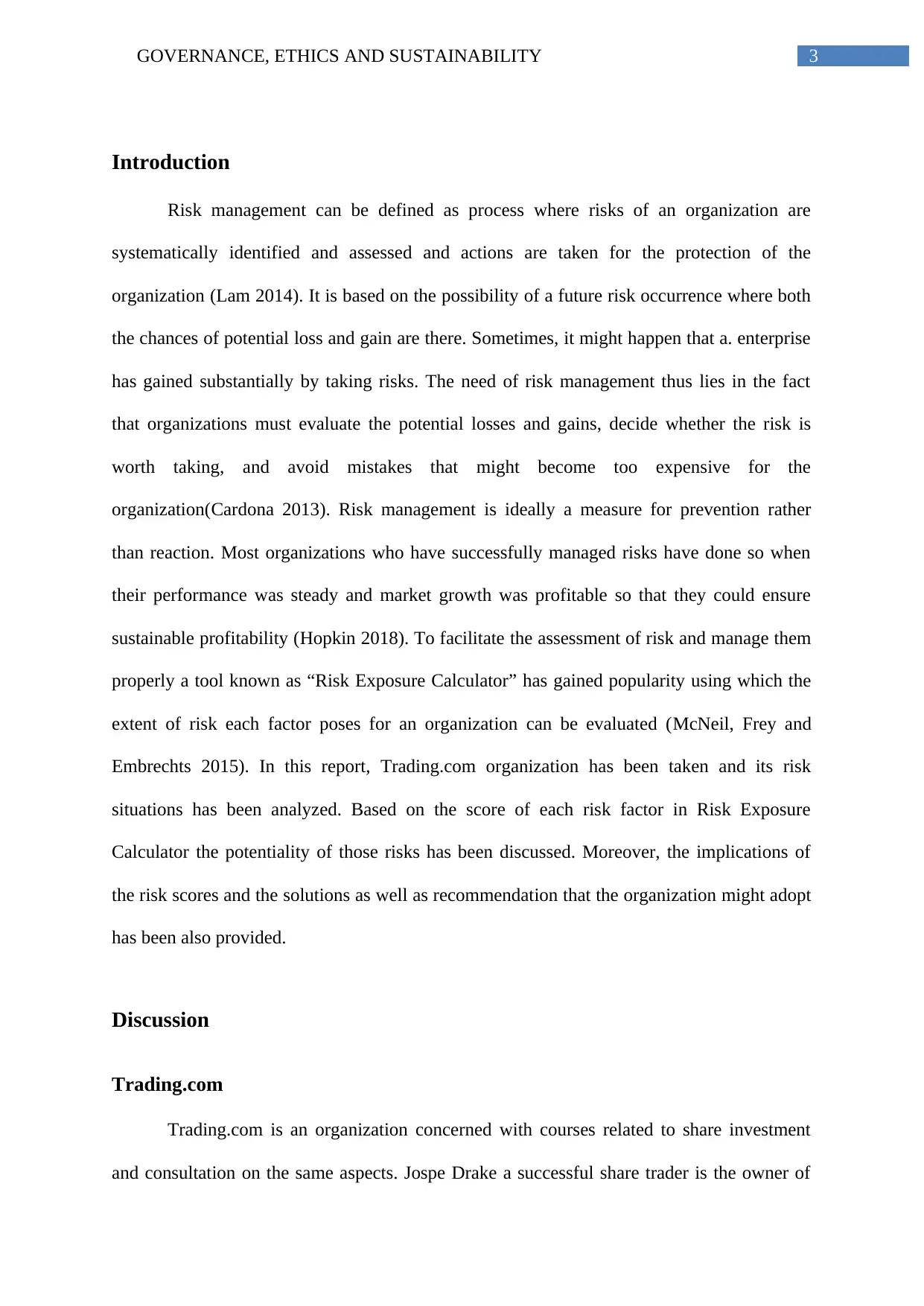
3GOVERNANCE, ETHICS AND SUSTAINABILITY
Introduction
Risk management can be defined as process where risks of an organization are
systematically identified and assessed and actions are taken for the protection of the
organization (Lam 2014). It is based on the possibility of a future risk occurrence where both
the chances of potential loss and gain are there. Sometimes, it might happen that a. enterprise
has gained substantially by taking risks. The need of risk management thus lies in the fact
that organizations must evaluate the potential losses and gains, decide whether the risk is
worth taking, and avoid mistakes that might become too expensive for the
organization(Cardona 2013). Risk management is ideally a measure for prevention rather
than reaction. Most organizations who have successfully managed risks have done so when
their performance was steady and market growth was profitable so that they could ensure
sustainable profitability (Hopkin 2018). To facilitate the assessment of risk and manage them
properly a tool known as “Risk Exposure Calculator” has gained popularity using which the
extent of risk each factor poses for an organization can be evaluated (McNeil, Frey and
Embrechts 2015). In this report, Trading.com organization has been taken and its risk
situations has been analyzed. Based on the score of each risk factor in Risk Exposure
Calculator the potentiality of those risks has been discussed. Moreover, the implications of
the risk scores and the solutions as well as recommendation that the organization might adopt
has been also provided.
Discussion
Trading.com
Trading.com is an organization concerned with courses related to share investment
and consultation on the same aspects. Jospe Drake a successful share trader is the owner of
Introduction
Risk management can be defined as process where risks of an organization are
systematically identified and assessed and actions are taken for the protection of the
organization (Lam 2014). It is based on the possibility of a future risk occurrence where both
the chances of potential loss and gain are there. Sometimes, it might happen that a. enterprise
has gained substantially by taking risks. The need of risk management thus lies in the fact
that organizations must evaluate the potential losses and gains, decide whether the risk is
worth taking, and avoid mistakes that might become too expensive for the
organization(Cardona 2013). Risk management is ideally a measure for prevention rather
than reaction. Most organizations who have successfully managed risks have done so when
their performance was steady and market growth was profitable so that they could ensure
sustainable profitability (Hopkin 2018). To facilitate the assessment of risk and manage them
properly a tool known as “Risk Exposure Calculator” has gained popularity using which the
extent of risk each factor poses for an organization can be evaluated (McNeil, Frey and
Embrechts 2015). In this report, Trading.com organization has been taken and its risk
situations has been analyzed. Based on the score of each risk factor in Risk Exposure
Calculator the potentiality of those risks has been discussed. Moreover, the implications of
the risk scores and the solutions as well as recommendation that the organization might adopt
has been also provided.
Discussion
Trading.com
Trading.com is an organization concerned with courses related to share investment
and consultation on the same aspects. Jospe Drake a successful share trader is the owner of
Paraphrase This Document
Need a fresh take? Get an instant paraphrase of this document with our AI Paraphraser
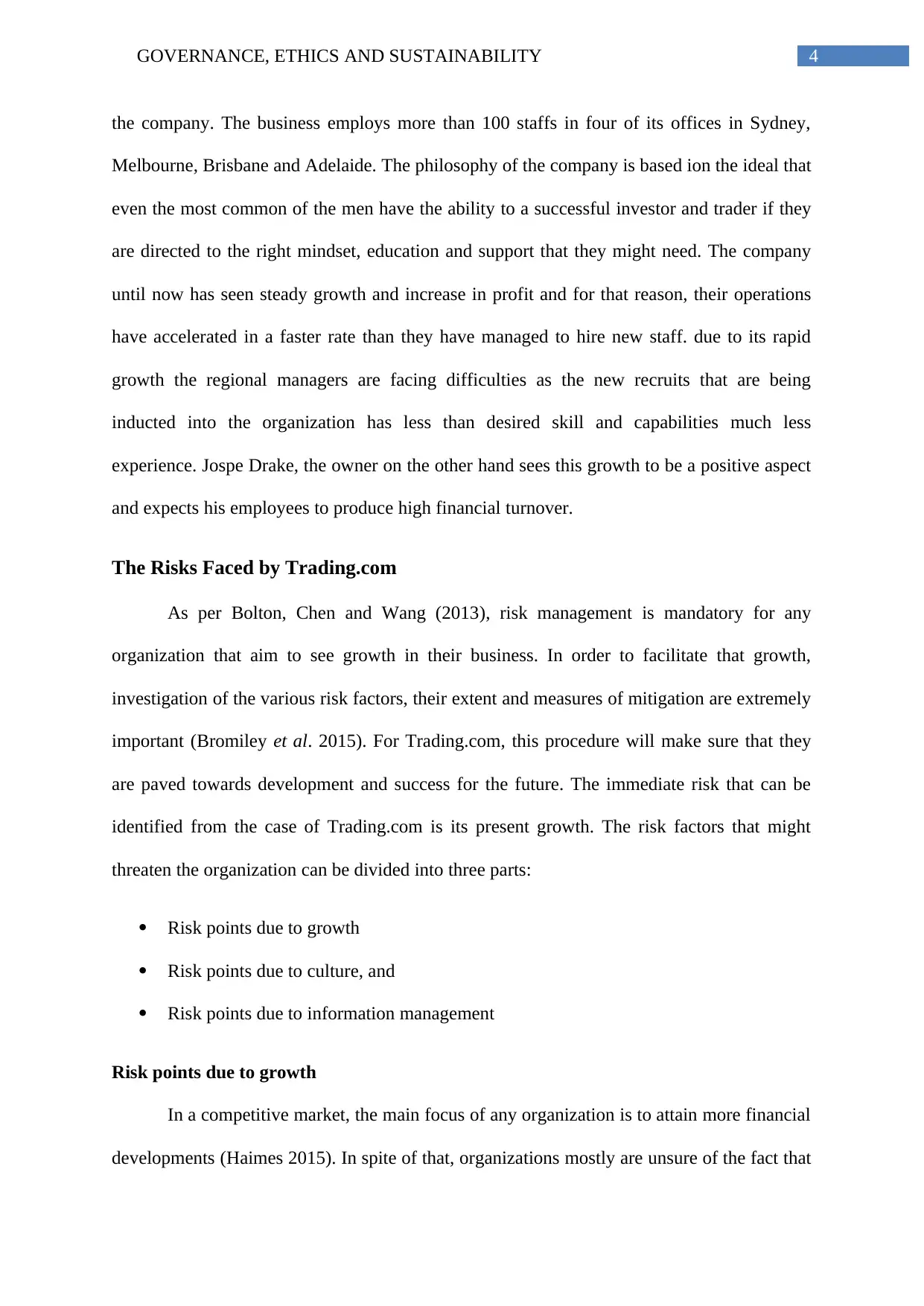
4GOVERNANCE, ETHICS AND SUSTAINABILITY
the company. The business employs more than 100 staffs in four of its offices in Sydney,
Melbourne, Brisbane and Adelaide. The philosophy of the company is based ion the ideal that
even the most common of the men have the ability to a successful investor and trader if they
are directed to the right mindset, education and support that they might need. The company
until now has seen steady growth and increase in profit and for that reason, their operations
have accelerated in a faster rate than they have managed to hire new staff. due to its rapid
growth the regional managers are facing difficulties as the new recruits that are being
inducted into the organization has less than desired skill and capabilities much less
experience. Jospe Drake, the owner on the other hand sees this growth to be a positive aspect
and expects his employees to produce high financial turnover.
The Risks Faced by Trading.com
As per Bolton, Chen and Wang (2013), risk management is mandatory for any
organization that aim to see growth in their business. In order to facilitate that growth,
investigation of the various risk factors, their extent and measures of mitigation are extremely
important (Bromiley et al. 2015). For Trading.com, this procedure will make sure that they
are paved towards development and success for the future. The immediate risk that can be
identified from the case of Trading.com is its present growth. The risk factors that might
threaten the organization can be divided into three parts:
Risk points due to growth
Risk points due to culture, and
Risk points due to information management
Risk points due to growth
In a competitive market, the main focus of any organization is to attain more financial
developments (Haimes 2015). In spite of that, organizations mostly are unsure of the fact that
the company. The business employs more than 100 staffs in four of its offices in Sydney,
Melbourne, Brisbane and Adelaide. The philosophy of the company is based ion the ideal that
even the most common of the men have the ability to a successful investor and trader if they
are directed to the right mindset, education and support that they might need. The company
until now has seen steady growth and increase in profit and for that reason, their operations
have accelerated in a faster rate than they have managed to hire new staff. due to its rapid
growth the regional managers are facing difficulties as the new recruits that are being
inducted into the organization has less than desired skill and capabilities much less
experience. Jospe Drake, the owner on the other hand sees this growth to be a positive aspect
and expects his employees to produce high financial turnover.
The Risks Faced by Trading.com
As per Bolton, Chen and Wang (2013), risk management is mandatory for any
organization that aim to see growth in their business. In order to facilitate that growth,
investigation of the various risk factors, their extent and measures of mitigation are extremely
important (Bromiley et al. 2015). For Trading.com, this procedure will make sure that they
are paved towards development and success for the future. The immediate risk that can be
identified from the case of Trading.com is its present growth. The risk factors that might
threaten the organization can be divided into three parts:
Risk points due to growth
Risk points due to culture, and
Risk points due to information management
Risk points due to growth
In a competitive market, the main focus of any organization is to attain more financial
developments (Haimes 2015). In spite of that, organizations mostly are unsure of the fact that
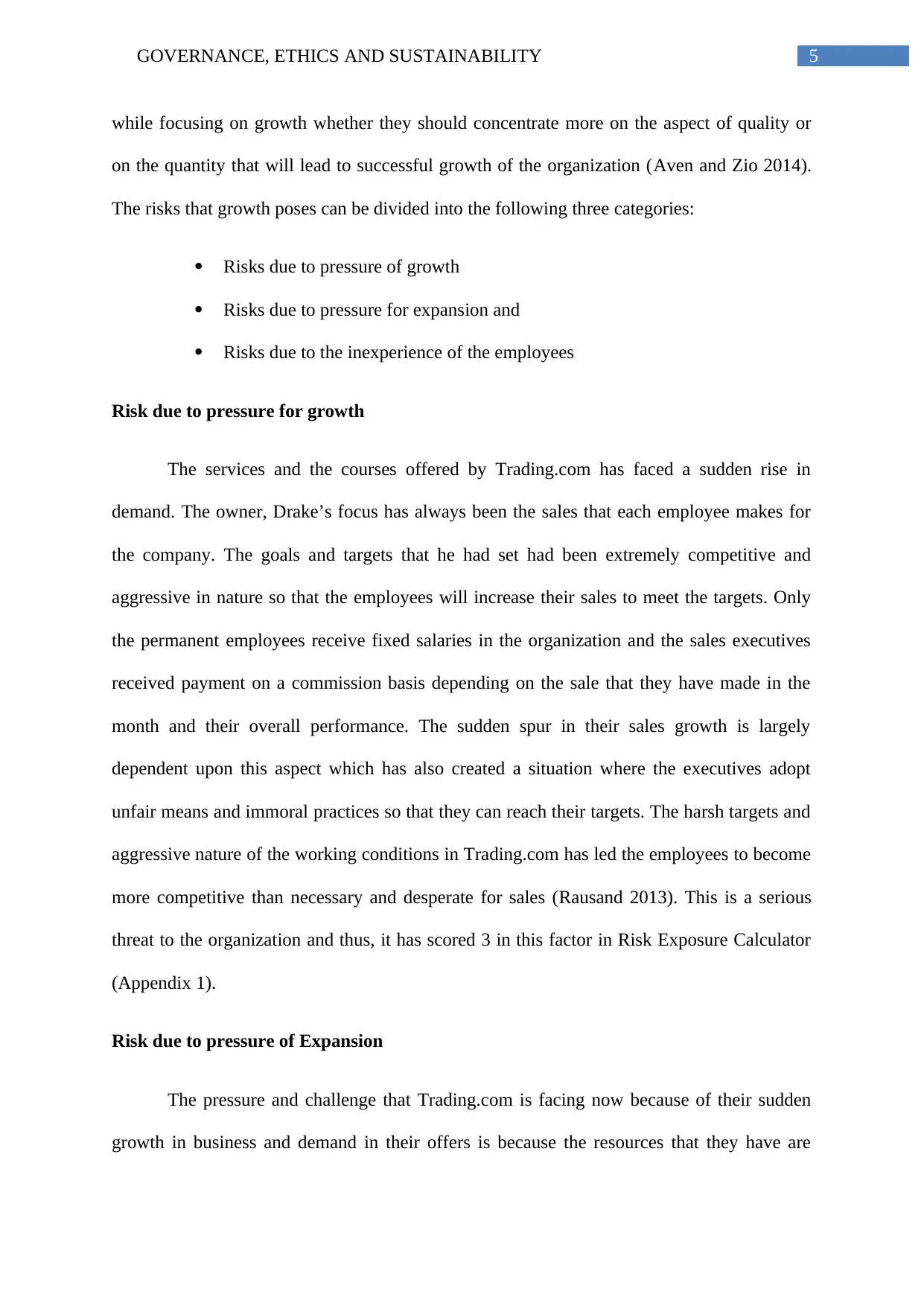
5GOVERNANCE, ETHICS AND SUSTAINABILITY
while focusing on growth whether they should concentrate more on the aspect of quality or
on the quantity that will lead to successful growth of the organization (Aven and Zio 2014).
The risks that growth poses can be divided into the following three categories:
Risks due to pressure of growth
Risks due to pressure for expansion and
Risks due to the inexperience of the employees
Risk due to pressure for growth
The services and the courses offered by Trading.com has faced a sudden rise in
demand. The owner, Drake’s focus has always been the sales that each employee makes for
the company. The goals and targets that he had set had been extremely competitive and
aggressive in nature so that the employees will increase their sales to meet the targets. Only
the permanent employees receive fixed salaries in the organization and the sales executives
received payment on a commission basis depending on the sale that they have made in the
month and their overall performance. The sudden spur in their sales growth is largely
dependent upon this aspect which has also created a situation where the executives adopt
unfair means and immoral practices so that they can reach their targets. The harsh targets and
aggressive nature of the working conditions in Trading.com has led the employees to become
more competitive than necessary and desperate for sales (Rausand 2013). This is a serious
threat to the organization and thus, it has scored 3 in this factor in Risk Exposure Calculator
(Appendix 1).
Risk due to pressure of Expansion
The pressure and challenge that Trading.com is facing now because of their sudden
growth in business and demand in their offers is because the resources that they have are
while focusing on growth whether they should concentrate more on the aspect of quality or
on the quantity that will lead to successful growth of the organization (Aven and Zio 2014).
The risks that growth poses can be divided into the following three categories:
Risks due to pressure of growth
Risks due to pressure for expansion and
Risks due to the inexperience of the employees
Risk due to pressure for growth
The services and the courses offered by Trading.com has faced a sudden rise in
demand. The owner, Drake’s focus has always been the sales that each employee makes for
the company. The goals and targets that he had set had been extremely competitive and
aggressive in nature so that the employees will increase their sales to meet the targets. Only
the permanent employees receive fixed salaries in the organization and the sales executives
received payment on a commission basis depending on the sale that they have made in the
month and their overall performance. The sudden spur in their sales growth is largely
dependent upon this aspect which has also created a situation where the executives adopt
unfair means and immoral practices so that they can reach their targets. The harsh targets and
aggressive nature of the working conditions in Trading.com has led the employees to become
more competitive than necessary and desperate for sales (Rausand 2013). This is a serious
threat to the organization and thus, it has scored 3 in this factor in Risk Exposure Calculator
(Appendix 1).
Risk due to pressure of Expansion
The pressure and challenge that Trading.com is facing now because of their sudden
growth in business and demand in their offers is because the resources that they have are
⊘ This is a preview!⊘
Do you want full access?
Subscribe today to unlock all pages.

Trusted by 1+ million students worldwide
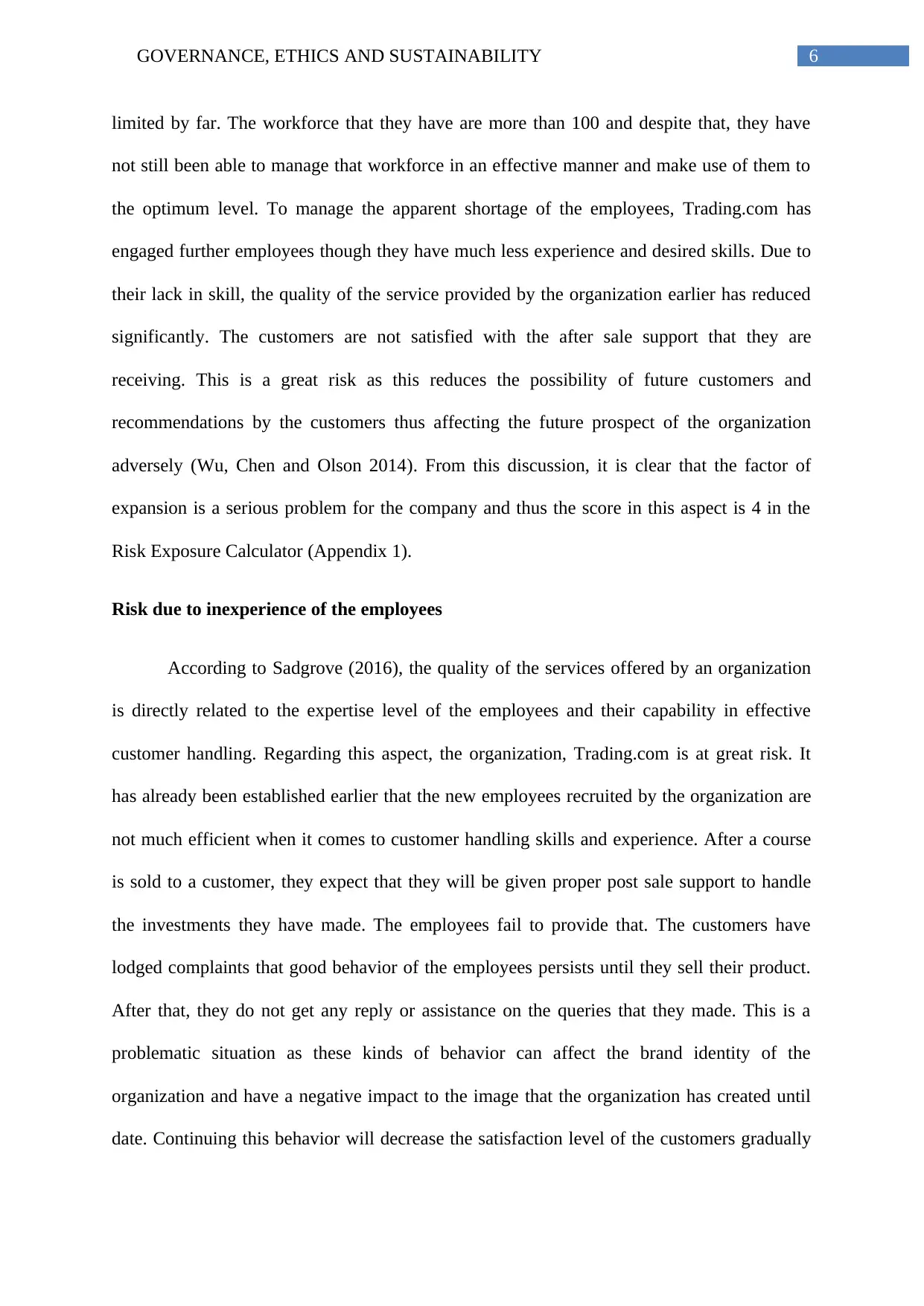
6GOVERNANCE, ETHICS AND SUSTAINABILITY
limited by far. The workforce that they have are more than 100 and despite that, they have
not still been able to manage that workforce in an effective manner and make use of them to
the optimum level. To manage the apparent shortage of the employees, Trading.com has
engaged further employees though they have much less experience and desired skills. Due to
their lack in skill, the quality of the service provided by the organization earlier has reduced
significantly. The customers are not satisfied with the after sale support that they are
receiving. This is a great risk as this reduces the possibility of future customers and
recommendations by the customers thus affecting the future prospect of the organization
adversely (Wu, Chen and Olson 2014). From this discussion, it is clear that the factor of
expansion is a serious problem for the company and thus the score in this aspect is 4 in the
Risk Exposure Calculator (Appendix 1).
Risk due to inexperience of the employees
According to Sadgrove (2016), the quality of the services offered by an organization
is directly related to the expertise level of the employees and their capability in effective
customer handling. Regarding this aspect, the organization, Trading.com is at great risk. It
has already been established earlier that the new employees recruited by the organization are
not much efficient when it comes to customer handling skills and experience. After a course
is sold to a customer, they expect that they will be given proper post sale support to handle
the investments they have made. The employees fail to provide that. The customers have
lodged complaints that good behavior of the employees persists until they sell their product.
After that, they do not get any reply or assistance on the queries that they made. This is a
problematic situation as these kinds of behavior can affect the brand identity of the
organization and have a negative impact to the image that the organization has created until
date. Continuing this behavior will decrease the satisfaction level of the customers gradually
limited by far. The workforce that they have are more than 100 and despite that, they have
not still been able to manage that workforce in an effective manner and make use of them to
the optimum level. To manage the apparent shortage of the employees, Trading.com has
engaged further employees though they have much less experience and desired skills. Due to
their lack in skill, the quality of the service provided by the organization earlier has reduced
significantly. The customers are not satisfied with the after sale support that they are
receiving. This is a great risk as this reduces the possibility of future customers and
recommendations by the customers thus affecting the future prospect of the organization
adversely (Wu, Chen and Olson 2014). From this discussion, it is clear that the factor of
expansion is a serious problem for the company and thus the score in this aspect is 4 in the
Risk Exposure Calculator (Appendix 1).
Risk due to inexperience of the employees
According to Sadgrove (2016), the quality of the services offered by an organization
is directly related to the expertise level of the employees and their capability in effective
customer handling. Regarding this aspect, the organization, Trading.com is at great risk. It
has already been established earlier that the new employees recruited by the organization are
not much efficient when it comes to customer handling skills and experience. After a course
is sold to a customer, they expect that they will be given proper post sale support to handle
the investments they have made. The employees fail to provide that. The customers have
lodged complaints that good behavior of the employees persists until they sell their product.
After that, they do not get any reply or assistance on the queries that they made. This is a
problematic situation as these kinds of behavior can affect the brand identity of the
organization and have a negative impact to the image that the organization has created until
date. Continuing this behavior will decrease the satisfaction level of the customers gradually
Paraphrase This Document
Need a fresh take? Get an instant paraphrase of this document with our AI Paraphraser
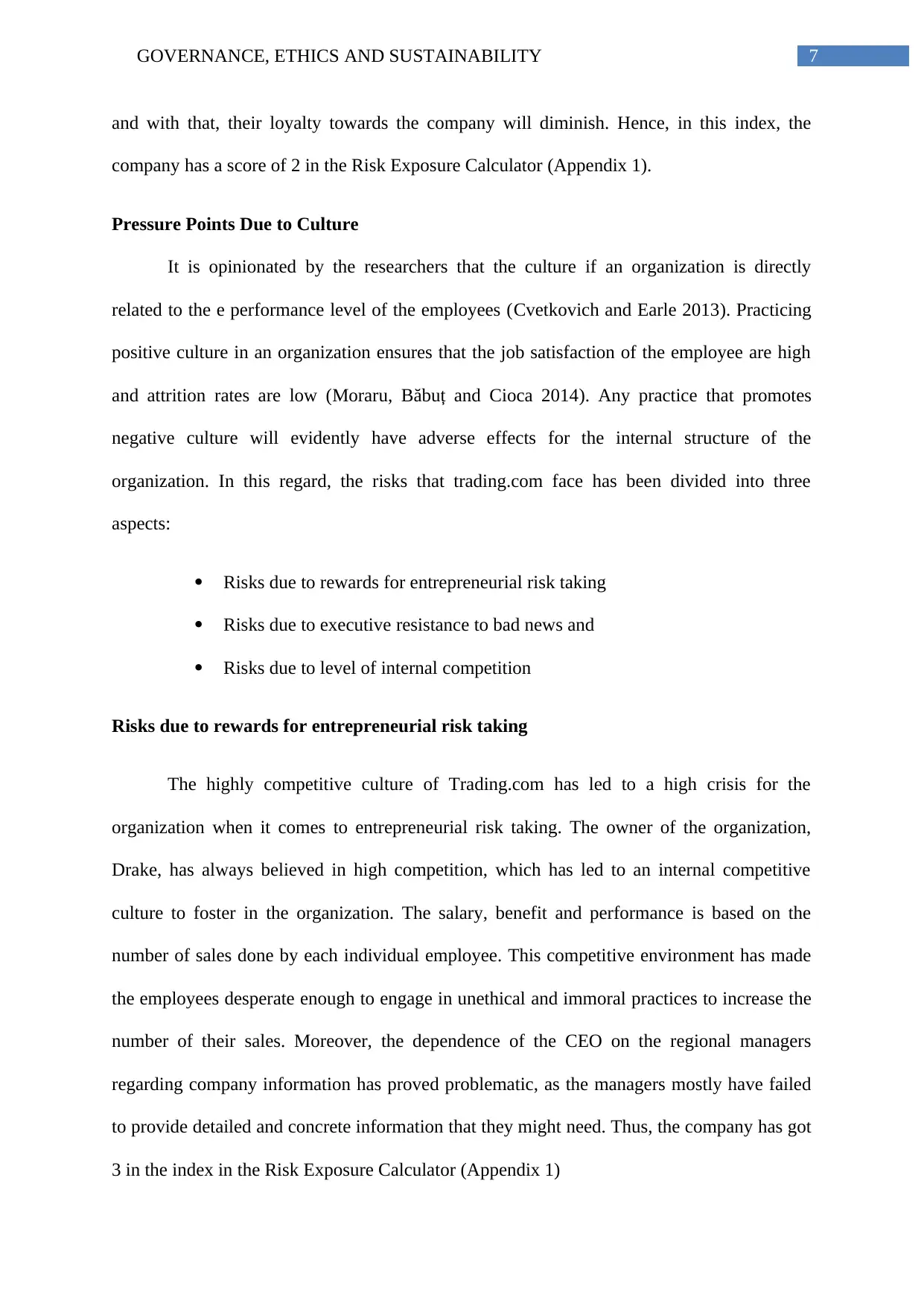
7GOVERNANCE, ETHICS AND SUSTAINABILITY
and with that, their loyalty towards the company will diminish. Hence, in this index, the
company has a score of 2 in the Risk Exposure Calculator (Appendix 1).
Pressure Points Due to Culture
It is opinionated by the researchers that the culture if an organization is directly
related to the e performance level of the employees (Cvetkovich and Earle 2013). Practicing
positive culture in an organization ensures that the job satisfaction of the employee are high
and attrition rates are low (Moraru, Băbuț and Cioca 2014). Any practice that promotes
negative culture will evidently have adverse effects for the internal structure of the
organization. In this regard, the risks that trading.com face has been divided into three
aspects:
Risks due to rewards for entrepreneurial risk taking
Risks due to executive resistance to bad news and
Risks due to level of internal competition
Risks due to rewards for entrepreneurial risk taking
The highly competitive culture of Trading.com has led to a high crisis for the
organization when it comes to entrepreneurial risk taking. The owner of the organization,
Drake, has always believed in high competition, which has led to an internal competitive
culture to foster in the organization. The salary, benefit and performance is based on the
number of sales done by each individual employee. This competitive environment has made
the employees desperate enough to engage in unethical and immoral practices to increase the
number of their sales. Moreover, the dependence of the CEO on the regional managers
regarding company information has proved problematic, as the managers mostly have failed
to provide detailed and concrete information that they might need. Thus, the company has got
3 in the index in the Risk Exposure Calculator (Appendix 1)
and with that, their loyalty towards the company will diminish. Hence, in this index, the
company has a score of 2 in the Risk Exposure Calculator (Appendix 1).
Pressure Points Due to Culture
It is opinionated by the researchers that the culture if an organization is directly
related to the e performance level of the employees (Cvetkovich and Earle 2013). Practicing
positive culture in an organization ensures that the job satisfaction of the employee are high
and attrition rates are low (Moraru, Băbuț and Cioca 2014). Any practice that promotes
negative culture will evidently have adverse effects for the internal structure of the
organization. In this regard, the risks that trading.com face has been divided into three
aspects:
Risks due to rewards for entrepreneurial risk taking
Risks due to executive resistance to bad news and
Risks due to level of internal competition
Risks due to rewards for entrepreneurial risk taking
The highly competitive culture of Trading.com has led to a high crisis for the
organization when it comes to entrepreneurial risk taking. The owner of the organization,
Drake, has always believed in high competition, which has led to an internal competitive
culture to foster in the organization. The salary, benefit and performance is based on the
number of sales done by each individual employee. This competitive environment has made
the employees desperate enough to engage in unethical and immoral practices to increase the
number of their sales. Moreover, the dependence of the CEO on the regional managers
regarding company information has proved problematic, as the managers mostly have failed
to provide detailed and concrete information that they might need. Thus, the company has got
3 in the index in the Risk Exposure Calculator (Appendix 1)
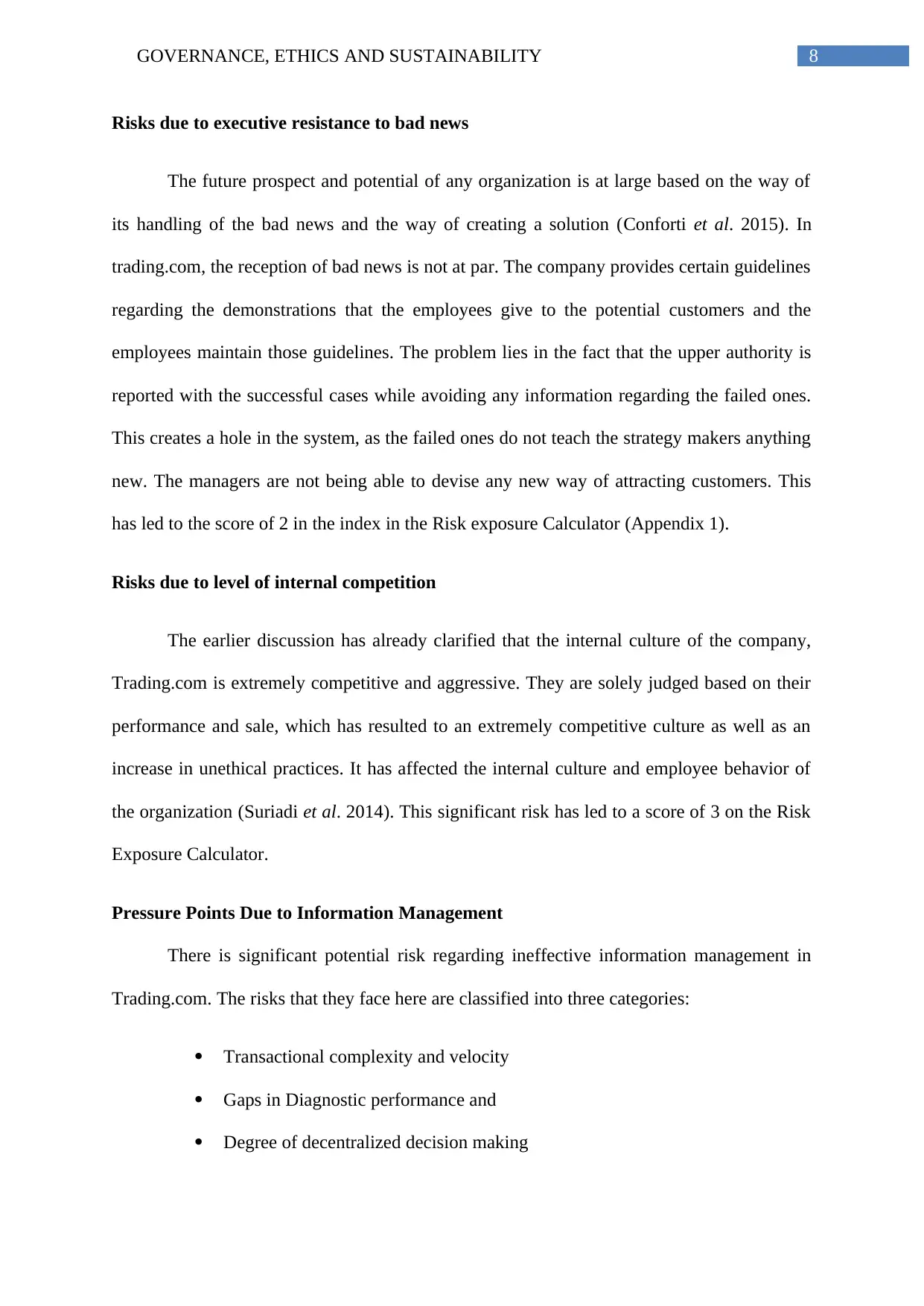
8GOVERNANCE, ETHICS AND SUSTAINABILITY
Risks due to executive resistance to bad news
The future prospect and potential of any organization is at large based on the way of
its handling of the bad news and the way of creating a solution (Conforti et al. 2015). In
trading.com, the reception of bad news is not at par. The company provides certain guidelines
regarding the demonstrations that the employees give to the potential customers and the
employees maintain those guidelines. The problem lies in the fact that the upper authority is
reported with the successful cases while avoiding any information regarding the failed ones.
This creates a hole in the system, as the failed ones do not teach the strategy makers anything
new. The managers are not being able to devise any new way of attracting customers. This
has led to the score of 2 in the index in the Risk exposure Calculator (Appendix 1).
Risks due to level of internal competition
The earlier discussion has already clarified that the internal culture of the company,
Trading.com is extremely competitive and aggressive. They are solely judged based on their
performance and sale, which has resulted to an extremely competitive culture as well as an
increase in unethical practices. It has affected the internal culture and employee behavior of
the organization (Suriadi et al. 2014). This significant risk has led to a score of 3 on the Risk
Exposure Calculator.
Pressure Points Due to Information Management
There is significant potential risk regarding ineffective information management in
Trading.com. The risks that they face here are classified into three categories:
Transactional complexity and velocity
Gaps in Diagnostic performance and
Degree of decentralized decision making
Risks due to executive resistance to bad news
The future prospect and potential of any organization is at large based on the way of
its handling of the bad news and the way of creating a solution (Conforti et al. 2015). In
trading.com, the reception of bad news is not at par. The company provides certain guidelines
regarding the demonstrations that the employees give to the potential customers and the
employees maintain those guidelines. The problem lies in the fact that the upper authority is
reported with the successful cases while avoiding any information regarding the failed ones.
This creates a hole in the system, as the failed ones do not teach the strategy makers anything
new. The managers are not being able to devise any new way of attracting customers. This
has led to the score of 2 in the index in the Risk exposure Calculator (Appendix 1).
Risks due to level of internal competition
The earlier discussion has already clarified that the internal culture of the company,
Trading.com is extremely competitive and aggressive. They are solely judged based on their
performance and sale, which has resulted to an extremely competitive culture as well as an
increase in unethical practices. It has affected the internal culture and employee behavior of
the organization (Suriadi et al. 2014). This significant risk has led to a score of 3 on the Risk
Exposure Calculator.
Pressure Points Due to Information Management
There is significant potential risk regarding ineffective information management in
Trading.com. The risks that they face here are classified into three categories:
Transactional complexity and velocity
Gaps in Diagnostic performance and
Degree of decentralized decision making
⊘ This is a preview!⊘
Do you want full access?
Subscribe today to unlock all pages.

Trusted by 1+ million students worldwide
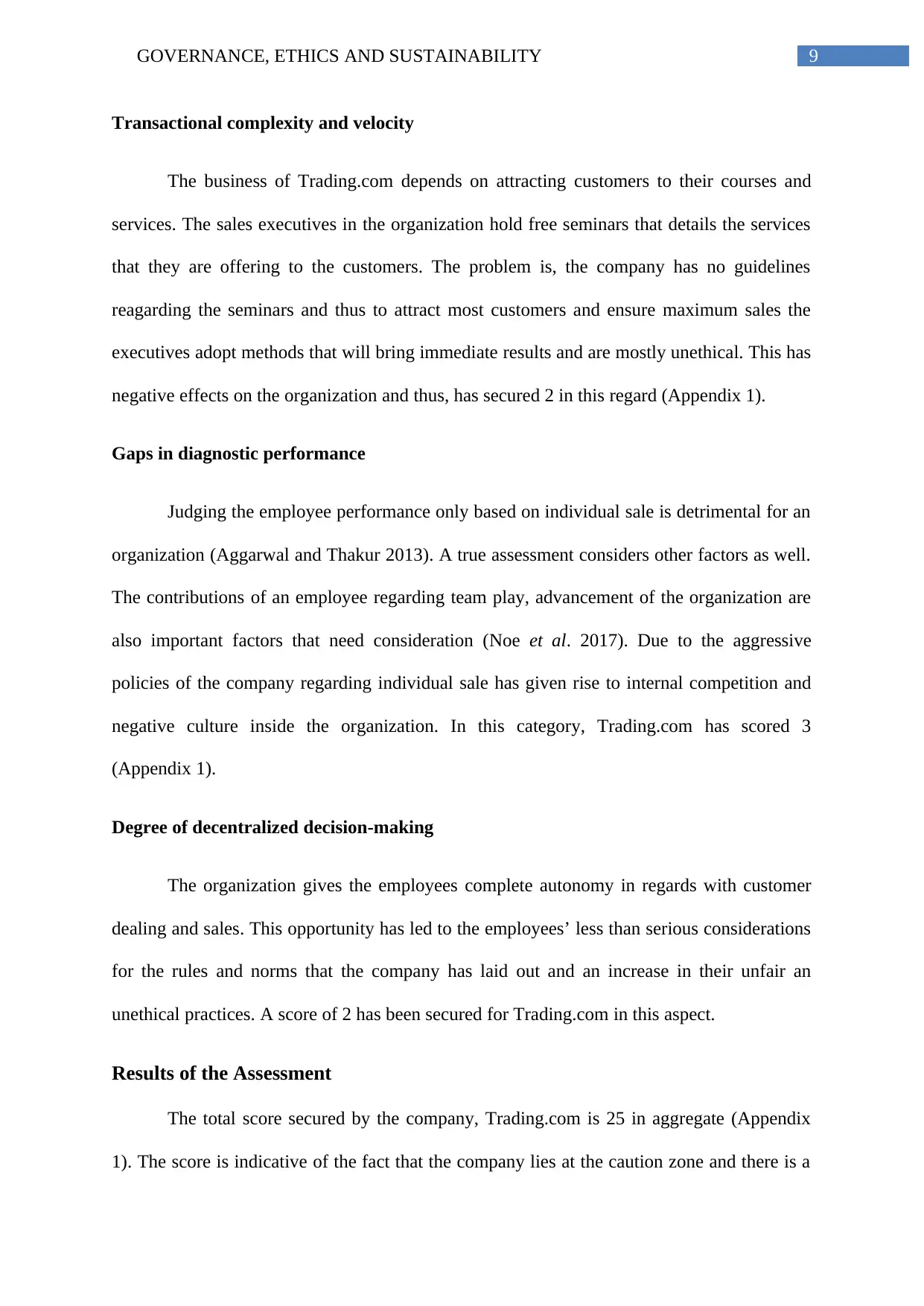
9GOVERNANCE, ETHICS AND SUSTAINABILITY
Transactional complexity and velocity
The business of Trading.com depends on attracting customers to their courses and
services. The sales executives in the organization hold free seminars that details the services
that they are offering to the customers. The problem is, the company has no guidelines
reagarding the seminars and thus to attract most customers and ensure maximum sales the
executives adopt methods that will bring immediate results and are mostly unethical. This has
negative effects on the organization and thus, has secured 2 in this regard (Appendix 1).
Gaps in diagnostic performance
Judging the employee performance only based on individual sale is detrimental for an
organization (Aggarwal and Thakur 2013). A true assessment considers other factors as well.
The contributions of an employee regarding team play, advancement of the organization are
also important factors that need consideration (Noe et al. 2017). Due to the aggressive
policies of the company regarding individual sale has given rise to internal competition and
negative culture inside the organization. In this category, Trading.com has scored 3
(Appendix 1).
Degree of decentralized decision-making
The organization gives the employees complete autonomy in regards with customer
dealing and sales. This opportunity has led to the employees’ less than serious considerations
for the rules and norms that the company has laid out and an increase in their unfair an
unethical practices. A score of 2 has been secured for Trading.com in this aspect.
Results of the Assessment
The total score secured by the company, Trading.com is 25 in aggregate (Appendix
1). The score is indicative of the fact that the company lies at the caution zone and there is a
Transactional complexity and velocity
The business of Trading.com depends on attracting customers to their courses and
services. The sales executives in the organization hold free seminars that details the services
that they are offering to the customers. The problem is, the company has no guidelines
reagarding the seminars and thus to attract most customers and ensure maximum sales the
executives adopt methods that will bring immediate results and are mostly unethical. This has
negative effects on the organization and thus, has secured 2 in this regard (Appendix 1).
Gaps in diagnostic performance
Judging the employee performance only based on individual sale is detrimental for an
organization (Aggarwal and Thakur 2013). A true assessment considers other factors as well.
The contributions of an employee regarding team play, advancement of the organization are
also important factors that need consideration (Noe et al. 2017). Due to the aggressive
policies of the company regarding individual sale has given rise to internal competition and
negative culture inside the organization. In this category, Trading.com has scored 3
(Appendix 1).
Degree of decentralized decision-making
The organization gives the employees complete autonomy in regards with customer
dealing and sales. This opportunity has led to the employees’ less than serious considerations
for the rules and norms that the company has laid out and an increase in their unfair an
unethical practices. A score of 2 has been secured for Trading.com in this aspect.
Results of the Assessment
The total score secured by the company, Trading.com is 25 in aggregate (Appendix
1). The score is indicative of the fact that the company lies at the caution zone and there is a
Paraphrase This Document
Need a fresh take? Get an instant paraphrase of this document with our AI Paraphraser
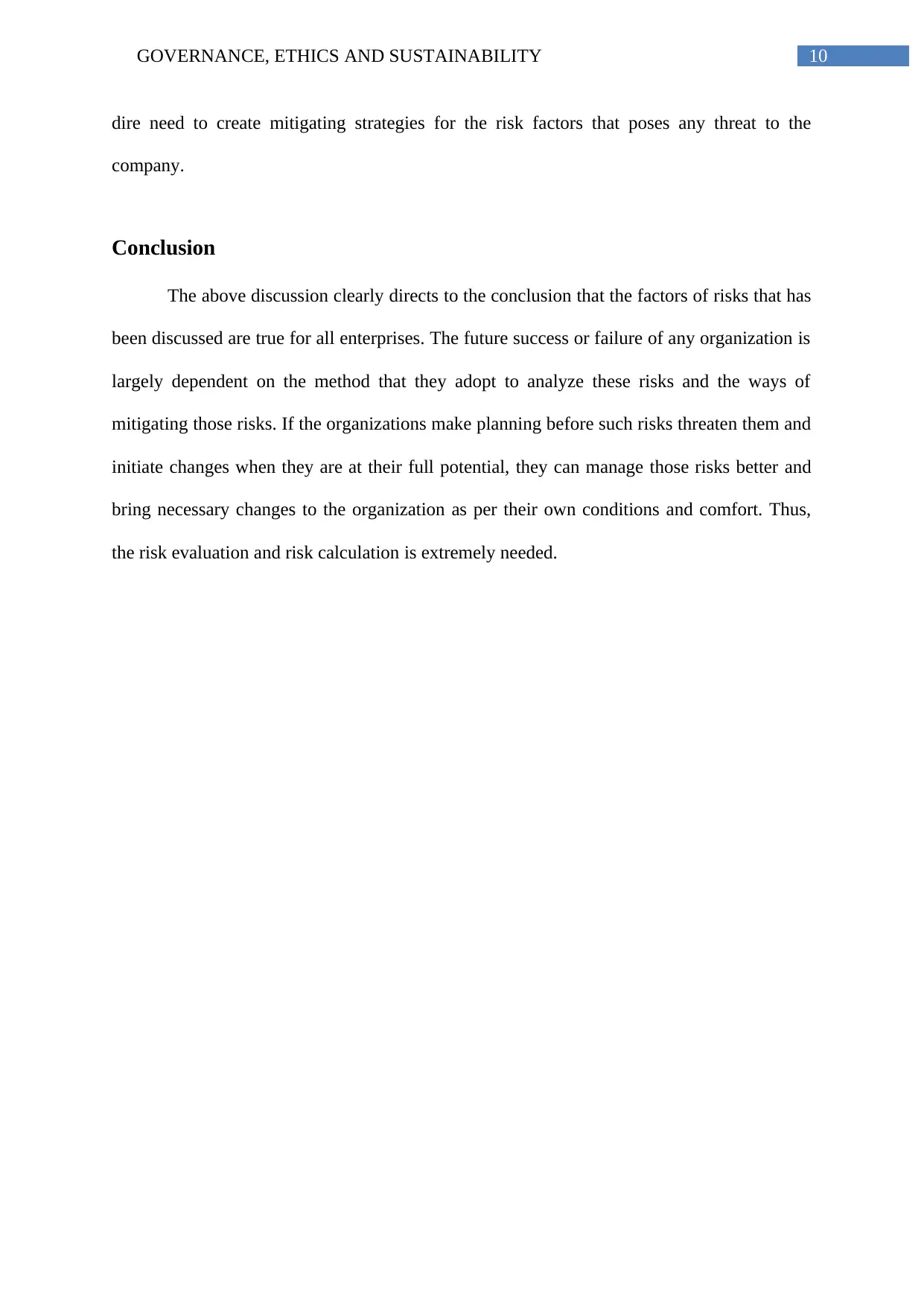
10GOVERNANCE, ETHICS AND SUSTAINABILITY
dire need to create mitigating strategies for the risk factors that poses any threat to the
company.
Conclusion
The above discussion clearly directs to the conclusion that the factors of risks that has
been discussed are true for all enterprises. The future success or failure of any organization is
largely dependent on the method that they adopt to analyze these risks and the ways of
mitigating those risks. If the organizations make planning before such risks threaten them and
initiate changes when they are at their full potential, they can manage those risks better and
bring necessary changes to the organization as per their own conditions and comfort. Thus,
the risk evaluation and risk calculation is extremely needed.
dire need to create mitigating strategies for the risk factors that poses any threat to the
company.
Conclusion
The above discussion clearly directs to the conclusion that the factors of risks that has
been discussed are true for all enterprises. The future success or failure of any organization is
largely dependent on the method that they adopt to analyze these risks and the ways of
mitigating those risks. If the organizations make planning before such risks threaten them and
initiate changes when they are at their full potential, they can manage those risks better and
bring necessary changes to the organization as per their own conditions and comfort. Thus,
the risk evaluation and risk calculation is extremely needed.
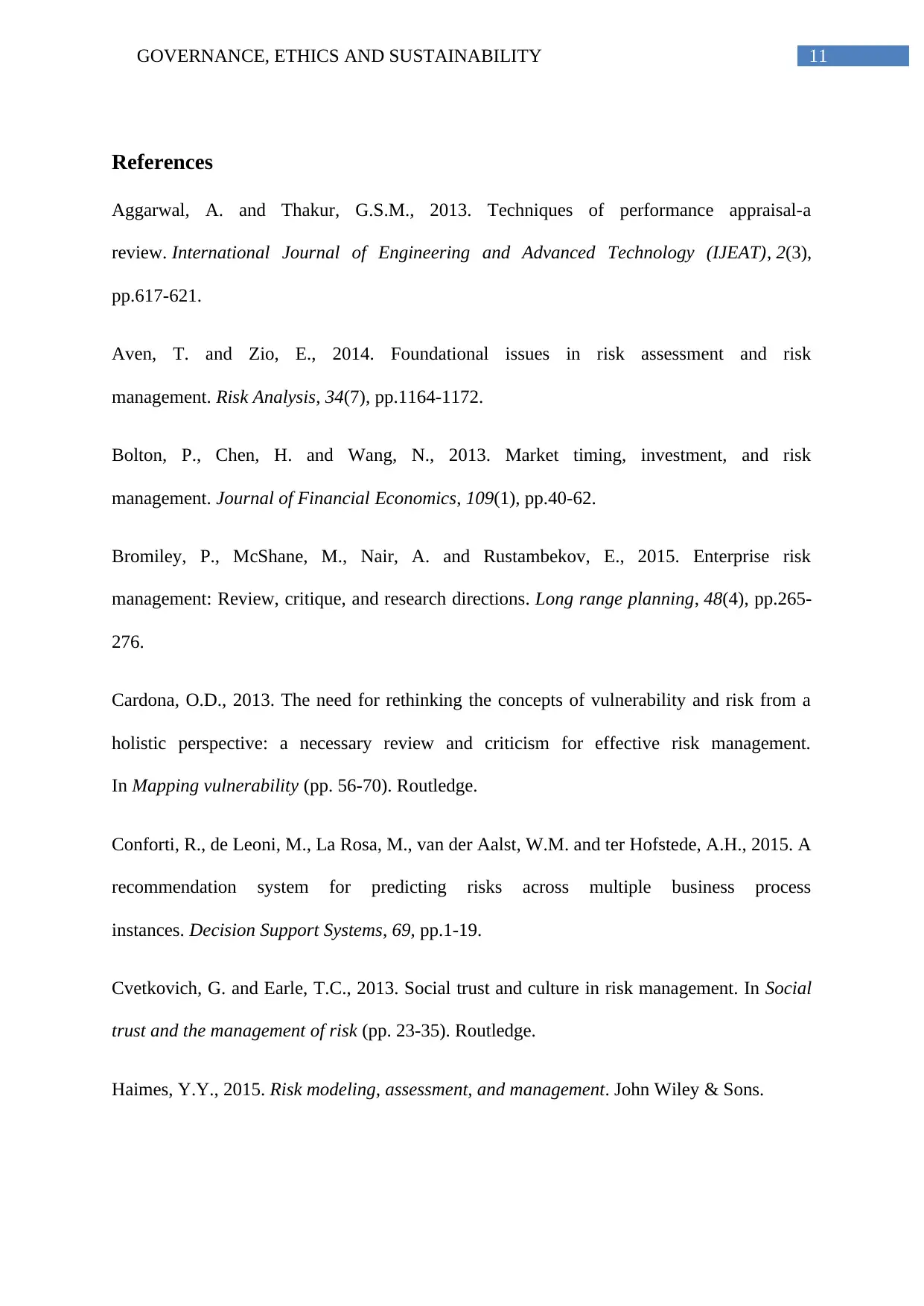
11GOVERNANCE, ETHICS AND SUSTAINABILITY
References
Aggarwal, A. and Thakur, G.S.M., 2013. Techniques of performance appraisal-a
review. International Journal of Engineering and Advanced Technology (IJEAT), 2(3),
pp.617-621.
Aven, T. and Zio, E., 2014. Foundational issues in risk assessment and risk
management. Risk Analysis, 34(7), pp.1164-1172.
Bolton, P., Chen, H. and Wang, N., 2013. Market timing, investment, and risk
management. Journal of Financial Economics, 109(1), pp.40-62.
Bromiley, P., McShane, M., Nair, A. and Rustambekov, E., 2015. Enterprise risk
management: Review, critique, and research directions. Long range planning, 48(4), pp.265-
276.
Cardona, O.D., 2013. The need for rethinking the concepts of vulnerability and risk from a
holistic perspective: a necessary review and criticism for effective risk management.
In Mapping vulnerability (pp. 56-70). Routledge.
Conforti, R., de Leoni, M., La Rosa, M., van der Aalst, W.M. and ter Hofstede, A.H., 2015. A
recommendation system for predicting risks across multiple business process
instances. Decision Support Systems, 69, pp.1-19.
Cvetkovich, G. and Earle, T.C., 2013. Social trust and culture in risk management. In Social
trust and the management of risk (pp. 23-35). Routledge.
Haimes, Y.Y., 2015. Risk modeling, assessment, and management. John Wiley & Sons.
References
Aggarwal, A. and Thakur, G.S.M., 2013. Techniques of performance appraisal-a
review. International Journal of Engineering and Advanced Technology (IJEAT), 2(3),
pp.617-621.
Aven, T. and Zio, E., 2014. Foundational issues in risk assessment and risk
management. Risk Analysis, 34(7), pp.1164-1172.
Bolton, P., Chen, H. and Wang, N., 2013. Market timing, investment, and risk
management. Journal of Financial Economics, 109(1), pp.40-62.
Bromiley, P., McShane, M., Nair, A. and Rustambekov, E., 2015. Enterprise risk
management: Review, critique, and research directions. Long range planning, 48(4), pp.265-
276.
Cardona, O.D., 2013. The need for rethinking the concepts of vulnerability and risk from a
holistic perspective: a necessary review and criticism for effective risk management.
In Mapping vulnerability (pp. 56-70). Routledge.
Conforti, R., de Leoni, M., La Rosa, M., van der Aalst, W.M. and ter Hofstede, A.H., 2015. A
recommendation system for predicting risks across multiple business process
instances. Decision Support Systems, 69, pp.1-19.
Cvetkovich, G. and Earle, T.C., 2013. Social trust and culture in risk management. In Social
trust and the management of risk (pp. 23-35). Routledge.
Haimes, Y.Y., 2015. Risk modeling, assessment, and management. John Wiley & Sons.
⊘ This is a preview!⊘
Do you want full access?
Subscribe today to unlock all pages.

Trusted by 1+ million students worldwide
1 out of 14
Related Documents
Your All-in-One AI-Powered Toolkit for Academic Success.
+13062052269
info@desklib.com
Available 24*7 on WhatsApp / Email
![[object Object]](/_next/static/media/star-bottom.7253800d.svg)
Unlock your academic potential
Copyright © 2020–2025 A2Z Services. All Rights Reserved. Developed and managed by ZUCOL.



